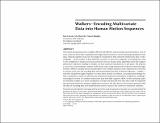Walkers—encoding multivariate data into human motion sequences
Abstract
The human perceptual system is highly efficient and effective at processing visual information, even at a pre-conscious level. Data visualisation leverages these functions to extract meaning and patterns from data, reducing cognitive load. Yet, the design of visualisations that represent multivariate data is still a challenge — as the number of data attributes increases, so does the complexity of visualisations, with it, the complexity of analysis processes potential users are facing. Many algorithms exist that support dimension reduction, leading to simpler, yet less nuanced visualisations in 2D space. We propose a novel way of presenting complex multivariate data using dimensional reduction that leverages humans’ ability to quickly process and decipher even complex sequences and compositions of motions to extract social cues. By encoding data into biomechanical motion of abstract figurines—“walkers”— and then using Point Light Displays to convey their motion in isolation, our proposed technique for data visualisation results in subconscious dimensional reduction and pattern recognition, enabling a meaningful overview of complex multivariate data with little cognitive effort. In this workshop paper, we introduce walkers as a novel visualisation concept and describe how this idea could be integrated into potential immersive analytics application scenarios. We also discuss the research questions that the idea of encoding data into biomechanical motion raises in the context of immersive analytics.
Citation
Carson , I , Hinrichs , U & Quigley , A J 2019 , ' Walkers—encoding multivariate data into human motion sequences ' , Paper presented at Immersive Analytics: Interaction Design and Prototyping for Immersive Analytics: co-located with the CHI 2019 the ACM Conference on Human Factors in Computing Systems , Glasgow , United Kingdom , 5/05/19 - 5/05/19 . workshop
Status
Peer reviewed
Type
Conference paper
Collections
Items in the St Andrews Research Repository are protected by copyright, with all rights reserved, unless otherwise indicated.

